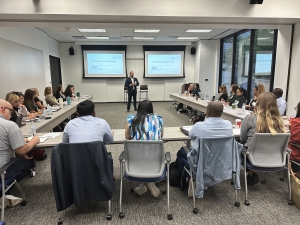To keep Membership up-to-date with the latest thinking from industry analysts, PESA hosted a market outlook with Joe Hoepfl, Partner; Allen Brooks and John Schissler, Managing Directors, PPHB, who shared their thoughts challenges for the oil market recovery, potential potholes and the environment for service companies.
LESSONS FROM PREVIOUS CYCLES
Brooks opened by contrasting the current decline with previous downturns. What caused the 2020 drop is an exaggerated imbalance between supply and demand created by government mandated shutdowns, he said. Before the pandemic, conditions were similar to the late 1970s boom when the industry experienced 34 months of real oil prices above $90. Before March, the industry saw more than 68 months of high prices.
Brooks noted how OPEC is less impactful in today’s oil market and the lack of a strong global organization to regulate prices leads to increased volatility – which could mean $100 oil again. High prices led to the shale revolution because they covered the expense of hydraulic fracturing. The shale revolution altered global oil markets and changed America’s relationship with Saudi Arabia and Russia.
Looking to future recovery, Brooks said to expect an initial “V-shaped” recovery that might run out of steam and be followed by modest growth. Changes to lifestyles and work routines will determine the impact on future oil demand growth. Challenges to navigating the oil market recovery include the U.S. Presidential elections and November’s OPEC meeting.
POTENTIAL POTHOLES FOR SERVICES COMPANIES
Schissler focused on what companies can do to grow during the current downturn and emphasized “cash is king.” He said companies need 18 months of cash on hand. During a downturn, service companies need to shrink as much as possible to save money and energy for when production and global markets return. He also said service companies need to focus on paying down debt rather than spend on drilling.
To achieve positive cash flow, companies need to focus on liquidity by accelerating receivables, stretching payables and disposing of underutilized assets. Companies can lower labor costs by implementing improved software and automatization. Schissler noted that balancing expenses is a difficult challenge and that companies should focus on renegotiating pricing and consolidating vendors.
M&A ENVIRONMENT
Hoepfl said the environment for OFS mergers and acquisitions is internal. As companies are in forced hibernation, they’ll look for opportunities to buy distressed assets. Certain deals will require restructuring alongside acquisitions.
He said that deals will get done in lower and middle markets. When the crisis is over, he anticipates a smaller, less robust shale market. The industry will continue the move towards efficiency and technology. Service companies must make enough profit to reinvest in people, technology and equipment – something that PESA has advocated for as the sector loses talent.
Some investors will leave the sector, but there will be continued investment by private equity. The bar for investment has been raised and investors now approach opportunities with discipline.
[gdlr_button href=”https://energyworkforce.org/wp-content/uploads/2020/06/PESA-Webinar-PPHB-Market-Outlook-06.18.20.pdf” target=”_self” size=”medium” background=”#3d90c7″ color=”#ffffff”]PRESENTATION[/gdlr_button] [gdlr_button href=”https://my.quikbox.com/2Z95wF5″ target=”_self” size=”medium” background=”#3d90c7″ color=”#ffffff”]WATCH THE WEBINAR[/gdlr_button]




